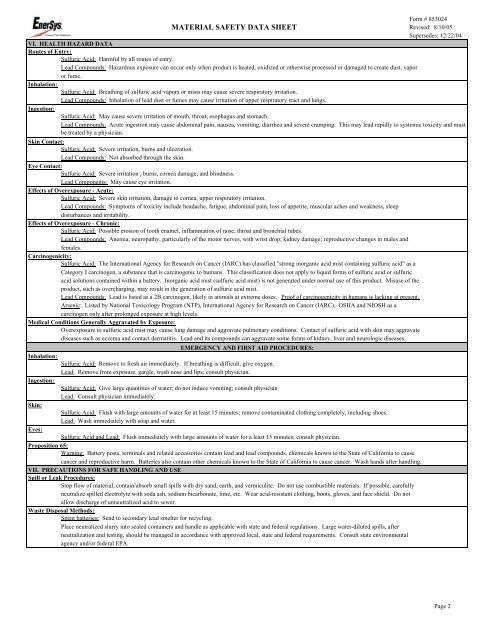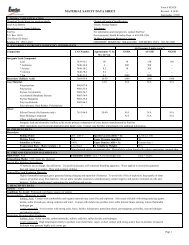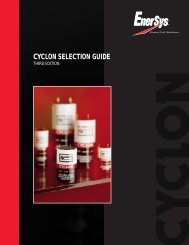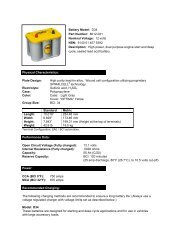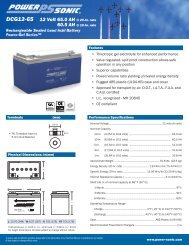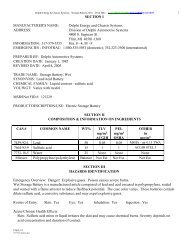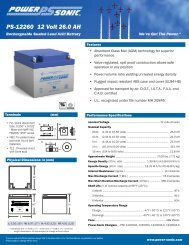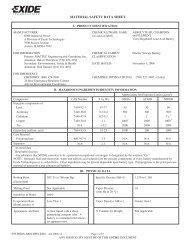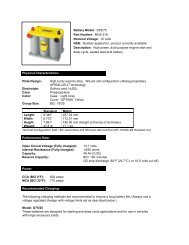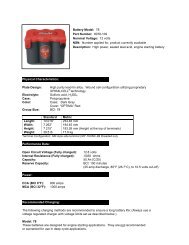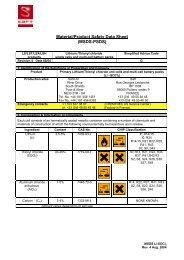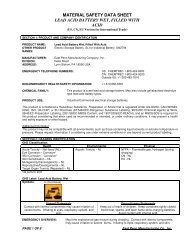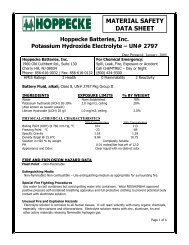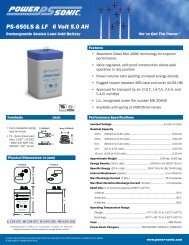Yuasa Battery MSDS - Falcon Electric
Yuasa Battery MSDS - Falcon Electric
Yuasa Battery MSDS - Falcon Electric
You also want an ePaper? Increase the reach of your titles
YUMPU automatically turns print PDFs into web optimized ePapers that Google loves.
Form # 853024<br />
MATERIAL SAFETY DATA SHEET<br />
Revised: 8/10/05<br />
Supersedes: 12/22/04<br />
VI. HEALTH HAZARD DATA<br />
Routes of Entry:<br />
Sulfuric Acid: Harmful by all routes of entry.<br />
Lead Compounds: Hazardous exposure can occur only when product is heated, oxidized or otherwise processed or damaged to create dust, vapor<br />
or fume.<br />
Inhalation:<br />
Sulfuric Acid: Breathing of sulfuric acid vapors or mists may cause severe respiratory irritation.<br />
Lead Compounds: Inhalation of lead dust or fumes may cause irritation of upper respiratory tract and lungs.<br />
Ingestion:<br />
Sulfuric Acid: May cause severe irritation of mouth, throat, esophagus and stomach.<br />
Lead Compounds: Acute ingestion may cause abdominal pain, nausea, vomiting, diarrhea and severe cramping. This may lead rapidly to systemic toxicity and must<br />
be treated by a physician.<br />
Skin Contact:<br />
Sulfuric Acid: Severe irritation, burns and ulceration.<br />
Lead Compounds: Not absorbed through the skin.<br />
Eye Contact:<br />
Sulfuric Acid: Severe irritation , burns, cornea damage, and blindness.<br />
Lead Components: May cause eye irritation.<br />
Effects of Overexposure - Acute:<br />
Sulfuric Acid: Severe skin irritation, damage to cornea, upper respiratory irritation.<br />
Lead Compounds: Symptoms of toxicity include headache, fatigue, abdominal pain, loss of appetite, muscular aches and weakness, sleep<br />
disturbances and irritability.<br />
Effects of Overexposure - Chronic:<br />
Sulfuric Acid: Possible erosion of tooth enamel, inflammation of nose, throat and bronchial tubes.<br />
Lead Compounds: Anemia; neuropathy, particularly of the motor nerves, with wrist drop; kidney damage; reproductive changes in males and<br />
females.<br />
Carcinogenicity:<br />
Sulfuric Acid: The International Agency for Research on Cancer (IARC) has classified "strong inorganic acid mist containing sulfuric acid" as a<br />
Category I carcinogen, a substance that is carcinogenic to humans. This classification does not apply to liquid forms of sulfuric acid or sulfuric<br />
acid solutions contained within a battery. Inorganic acid mist (sulfuric acid mist) is not generated under normal use of this product. Misuse of the<br />
product, such as overcharging, may result in the generation of sulfuric acid mist.<br />
Lead Compounds: Lead is listed as a 2B carcinogen, likely in animals at extreme doses. Proof of carcinogenicity in humans is lacking at present.<br />
Arsenic: Listed by National Toxicology Program (NTP), International Agency for Research on Cancer (IARC), OSHA and NIOSH as a<br />
carcinogen only after prolonged exposure at high levels.<br />
Medical Conditions Generally Aggravated by Exposure:<br />
Overexposure to sulfuric acid mist may cause lung damage and aggravate pulmonary conditions. Contact of sulfuric acid with skin may aggravate<br />
diseases such as eczema and contact dermatitis. Lead and its compounds can aggravate some forms of kidney, liver and neurologic diseases.<br />
EMERGENCY AND FIRST AID PROCEDURES:<br />
Inhalation:<br />
Sulfuric Acid: Remove to fresh air immediately. If breathing is difficult, give oxygen.<br />
Lead: Remove from exposure, gargle, wash nose and lips; consult physician.<br />
Ingestion:<br />
Sulfuric Acid: Give large quantities of water; do not induce vomiting; consult physician.<br />
Lead: Consult physician immediately.<br />
Skin:<br />
Sulfuric Acid: Flush with large amounts of water for at least 15 minutes; remove contaminated clothing completely, including shoes.<br />
Lead: Wash immediately with soap and water.<br />
Eyes:<br />
Sulfuric Acid and Lead: Flush immediately with large amounts of water for a least 15 minutes; consult physician.<br />
Proposition 65:<br />
Warning: <strong>Battery</strong> posts, terminals and related accessories contain lead and lead compounds, chemicals known to the State of California to cause<br />
cancer and reproductive harm. Batteries also contain other chemicals known to the State of California to cause cancer. Wash hands after handling.<br />
VII. PRECAUTIONS FOR SAFE HANDLING AND USE<br />
Spill or Leak Procedures:<br />
Stop flow of material, contain/absorb small spills with dry sand, earth, and vermiculite. Do not use combustible materials. If possible, carefully<br />
neutralize spilled electrolyte with soda ash, sodium bicarbonate, lime, etc. Wear acid-resistant clothing, boots, gloves, and face shield. Do not<br />
allow discharge of unneutralized acid to sewer.<br />
Waste Disposal Methods:<br />
Spent batteries: Send to secondary lead smelter for recycling.<br />
Place neutralized slurry into sealed containers and handle as applicable with state and federal regulations. Large water-diluted spills, after<br />
neutralization and testing, should be managed in accordance with approved local, state and federal requirements. Consult state environmental<br />
agency and/or federal EPA.<br />
Page 2


